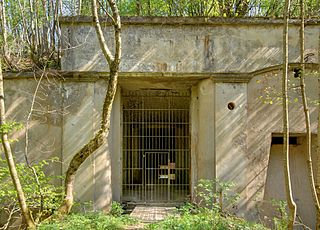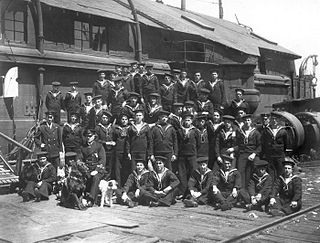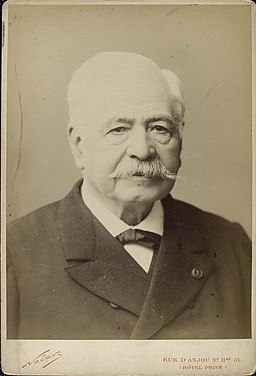
The Battle of Manila Bay, also known as the Battle of Cavite, took place on 1 May 1898, during the Spanish–American War. The American Asiatic Squadron under Commodore George Dewey engaged and destroyed the Spanish Pacific Squadron under Contraalmirante Patricio Montojo. The battle took place in Manila Bay in the Philippines, and was the first major engagement of the Spanish–American War. The battle was one of the most decisive naval battles in history and marked the end of the Spanish colonial period in Philippine history.

Garrison Point Fort is a former artillery fort situated at the end of the Garrison Point peninsula at Sheerness on the Isle of Sheppey in Kent. Built in the 1860s in response to concerns about a possible French invasion, it was the last in a series of artillery batteries that had existed on the site since the mid-16th century. The fort's position enabled it to guard the strategic point where the River Medway meets the Thames. It is a rare example of a two-tiered casemated fort – one of only two of that era in the country – with a design that is otherwise similar to that of several of the other forts along the lower Thames. It remained operational until 1956 and is now used by the Sheerness Docks as a port installation.

Rinella Battery is a Victorian battery in Kalkara, Malta. It is commonly referred to as Fort Rinella, although it was never classified as a fort while in use. It contains one of two surviving Armstrong 100-ton guns.

Fort Hamilton is a United States Army installation in the southwestern corner of the New York City borough of Brooklyn, surrounded by the communities of Bay Ridge and Dyker Heights. It is one of several posts that are part of the region which is headquartered by the Military District of Washington. Its mission is to provide the New York metropolitan area with military installation support for the Army National Guard and the United States Army Reserve. The original fort was completed in 1831, with major additions made in the 1870s and 1900s. However, all defenses except about half of the original fort have been demolished or buried.

Fort Monroe is a decommissioned military installation in Hampton, Virginia at Old Point Comfort, the southern tip of the Virginia Peninsula, United States. Along with Fort Wool, Fort Monroe originally guarded the navigation channel between the Chesapeake Bay and Hampton Roads—the natural roadstead at the confluence of the Elizabeth, the Nansemond and the James rivers. Until disarmament in 1946, the areas protected by the fort were the entire Chesapeake Bay and Potomac River regions, including the water approaches to the cities of Washington, D.C. and Baltimore, Maryland, along with important shipyards and naval bases in the Hampton Roads area. Surrounded by a moat, the six-sided bastion fort is the largest fort by area ever built in the United States.

Fort Warren is a historic fort on the 28-acre (110,000 m2) Georges Island at the entrance to Boston Harbor. It is not to be confused with Fort Winthrop, which was named Fort Warren from 1808 to 1833.

Fort Saint Rocco, also known as Fort Saint Roca on some maps, is a polygonal fort in Kalkara, Malta. It is located east of Rinella Battery and seaward of the village of Santu Rokku, and forms part of the complex of shore batteries built by the British to defend the coast east of the mouth of Grand Harbour between the 1870s and 1900s.

Fort Worden and accompanying Fort Worden Historical State Park are located in Port Townsend, along Admiralty Inlet in Washington state. It is on 433 acres that originally was a United States Army installation to protect Puget Sound. Fort Worden was named after U.S. Navy Rear Admiral John Lorimer Worden, commander of USS Monitor during its famous battle during the American Civil War.

Saint Paul's Battery, also known as Ta' Lombardi Battery, is an artillery battery in Marsaxlokk, Malta. It stands on high ground at the shoreward end of Delimara Point, above il-Ħofra-z-Zgħira. It is a polygonal fort and was built by the British from 1881 to 1886. It commands a field of fire northwards over St Thomas' Bay and Marsaskala.

The Sandy Hook Proving Ground was a military facility along the Atlantic coast of New Jersey established by the Secretary of War on August 7, 1874, to serve as the United States Army's first proving ground for the testing of ordnance and materiel. The facility was located at Sandy Hook, a narrow coastal spit of land, approximately 6 miles (9.7 km) in length and 0.5 miles wide, in Middletown Township in Monmouth County. The facility was operated in conjunction with the adjoining Fort Hancock. Essentially abandoned in 1919 for a larger facility, the area was left to degrade and most of the structures still remain today. The proving ground and parts of Fort Hancock are now property of the National Park Service and mostly closed to the public.

Fort Strong is a former U.S. Army Coast Artillery fort that occupied the northern third of Long Island in Boston Harbor. The island had a training camp during the American Civil War, and a gun battery was built there in the 1870s. The fort was built in 1893-1906 during the Endicott period of expansion in U.S. coast defense, and was part of the Coast Defenses of Boston. Formerly, it was also known as Long Island Military Reservation. Before World War I, a large station for handling submarine mines was added to the fort's defenses. Prior to World War I the fort was probably manned by over 1,000 soldiers. During World War II, two batteries of 3-inch guns defended channel minefields, but the big guns and other 3-inch batteries were decommissioned. Declared surplus in 1947, the fort served as a Nike missile site until 1961, and was redeveloped in 2005-2009 for a children's summer camp and later a homeless shelter. However, in 2014 the island's bridge was demolished due to safety concerns, and all activities were removed.

Fort DeRussy is a United States military reservation in the Waikiki area of Honolulu, Hawaii, under the jurisdiction of the United States Army. Unfenced and largely open to public traffic, the installation consists mainly of landscaped greenspace. The former Battery Randolph now houses the U.S. Army Museum of Hawaiʻi, which is open to the public. The Hale Koa Hotel, an Armed Forces Recreation Center, and the Daniel K. Inouye Asia-Pacific Center for Security Studies are also located on Fort DeRussy.

Fort Levett was a former U.S. Army fort built on Cushing Island, Maine beginning in 1898. Located in Cumberland County, Maine, in Casco Bay near Portland, Maine, the fort was heavily fortified with guns for coastal defense. Conceived under the Endicott Program in 1885 and begun in the wake of the Spanish–American War, Fort Levett was manned during both World Wars. The fort's name is sometimes mis-spelled as "Fort Leavitt".

Fort de Roppe, also known as Fort Ney, was built between 1875 and 1877. It is part of the second ring of fortifications around the city of Belfort in northeastern France. This set of forts was built as part of the Séré de Rivières system and incorporated improvements to deal with the improvement in efficacy of artillery in the late 19th century.

Fort Waldegrave was a battery or an emplacement for heavy guns in St. John’s Newfoundland, strategically overlooking the Narrows and St John’s Harbour.
The 16th Coast Artillery Regiment was a Coast Artillery regiment in the United States Army, Along with the 15th Coast Artillery, it manned the Harbor Defenses of Honolulu and other fortified sites on Oahu, Hawaii from 1924 until broken up into battalions in August 1944 as part of an Army-wide reorganization. The regiment manned a large number of gun batteries at locations all over Oahu. Most of the forts where they were assigned were originally built 1899-1910, and had been in caretaker status for more than 30 years. On the morning of 7 December 1941, the soldiers of the 16th Coast Artillery manned their anti-aircraft guns, bringing down six of the attacking Japanese aircraft.

Fuerte de Isla Verde was a military installation formerly located in Algeciras, Spain. It occupied the Isla Verde, which gave its name to the city as a whole. The elongated island, which stood a short distance offshore of the city's old town, was already the site of an artillery battery in 1720. In 1734 the fort was constructed on the island to the plans of the military engineer Juan de Subreville. Further remodeling took place in 1745 under Lorenzo de Solís. The installation, which followed the roughly triangular shape of the island, was initially equipped with three batteries. These were:

Fort Standish was a coastal fort completed in 1907 and located on Lovell's Island in Massachusetts. Named after Myles Standish, the fort would serve to host up to 7 batteries until it was disarmed and deactivated in 1947. It was also named Lovell's Island Military Reservation during the early part of its existence. It was part of the Coast Defenses of Boston.

Garden Battery is an artillery battery in Sliema, Malta. It was built by the British between 1889 and 1894. The battery is located at Tigné Point, between Cambridge Battery and Fort Tigné.
Spinola Battery, also known as Fort Spinola, was an artillery battery in St. Julian's, Malta. It was built by the British between 1889 and 1894, and it was demolished to make way for hotels and a yacht marina.



















